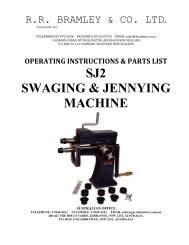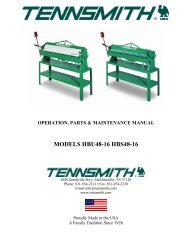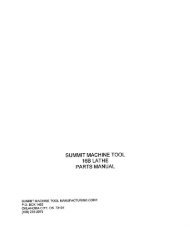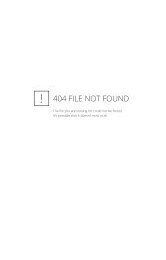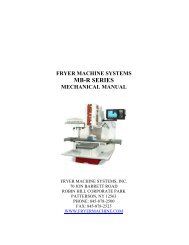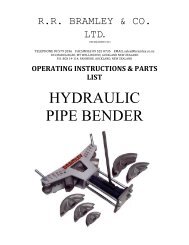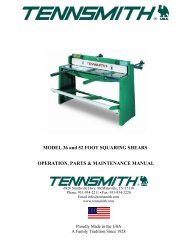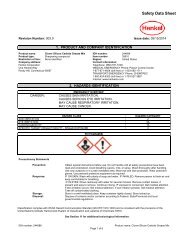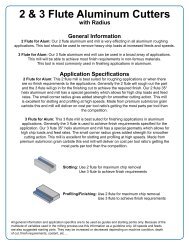MSDS - Production Tool Supply
MSDS - Production Tool Supply
MSDS - Production Tool Supply
Create successful ePaper yourself
Turn your PDF publications into a flip-book with our unique Google optimized e-Paper software.
SAFETY DATA SHEET<br />
1. Identification<br />
Product identifier<br />
Other means of identification<br />
Part Number 03620<br />
Recommended use<br />
Recommended restrictions<br />
LPS® TriFree®<br />
A spray brake cleaner designed to remove oil, grease, brake fluid, brake pad material or dirt from<br />
motor vehicle brake mechanisms.<br />
None known.<br />
Manufacturer/Importer/Supplier/Distributor information<br />
Manufacturer<br />
Manufacturer<br />
Company name<br />
Address<br />
Country<br />
In Case of Emergency<br />
Website<br />
E-mail<br />
LPS Laboratories, a division of Illinois <strong>Tool</strong> Works, Inc.<br />
4647 Hugh Howell Rd.<br />
Tucker, GA 30084<br />
(U.S.A.)<br />
Tel: +1 770-243-8800<br />
1-800-424-9300 (inside U.S.)<br />
+001 703-527-3887 (outside U.S.)<br />
www.lpslabs.com<br />
sds@lpslabs.com<br />
2. Hazard(s) identification<br />
Physical hazards<br />
Health hazards<br />
Environmental hazards<br />
OSHA defined hazards<br />
Label elements<br />
Flammable aerosols<br />
Gases under pressure<br />
Skin corrosion/irritation<br />
Serious eye damage/eye irritation<br />
Specific target organ toxicity, single exposure<br />
Aspiration hazard<br />
Not classified.<br />
Not classified.<br />
Category 1<br />
Compressed gas<br />
Category 2<br />
Category 2A<br />
Category 3 narcotic effects<br />
Category 1<br />
Signal word<br />
Hazard statement<br />
Precautionary statement<br />
Prevention<br />
Response<br />
Storage<br />
Danger<br />
Pressurized container: May burst if heated. Extremely flammable aerosol. Contains gas under<br />
pressure; may explode if heated. Causes skin irritation. Causes serious eye irritation. May cause<br />
drowsiness or dizziness. May be fatal if swallowed and enters airways.<br />
Keep away from heat/sparks/open flames/hot surfaces. - No smoking. Do not spray on an open<br />
flame or other ignition source. Pressurized container: Do not pierce or burn, even after use. Avoid<br />
breathing gas. Wash thoroughly after handling. Use only outdoors or in a well-ventilated area.<br />
Wear protective gloves. Wear eye/face protection.<br />
If swallowed: Immediately call a poison center/doctor. Do NOT induce vomiting. If on skin: Wash<br />
with plenty of water. Take off contaminated clothing and wash before reuse. Specific treatment<br />
(see this label). If skin irritation occurs: Get medical advice/attention. If in eyes: Rinse cautiously<br />
with water for several minutes. Remove contact lenses, if present and easy to do. Continue<br />
rinsing. If eye irritation persists: Get medical advice/attention. If inhaled: Remove person to fresh<br />
air and keep comfortable for breathing. Call a poison center/doctor if you feel unwell.<br />
Store in a well-ventilated place. Keep container tightly closed. Store locked up. Protect from<br />
sunlight. Do not expose to temperatures exceeding 50°C/122°F.<br />
Material name: LPS® TriFree®<br />
798 Version #: 01 Issue date: 09-04-2014<br />
SDS US<br />
1 / 11
Disposal<br />
Hazard(s) not otherwise<br />
classified (HNOC)<br />
Supplemental information<br />
Dispose of contents/container in accordance with local/regional/national/international regulations.<br />
None known.<br />
None.<br />
3. Composition/information on ingredients<br />
Mixtures<br />
Chemical name<br />
Common name and synonyms<br />
CAS number %<br />
Acetone 67-64-1<br />
50 - 60<br />
Heptane 142-82-5<br />
20 - 30<br />
Cyclohexylmethane 108-87-2<br />
10 - 20<br />
Carbon Dioxide 124-38-9<br />
1 - 5<br />
Primary Amyl Acetate 628-63-7<br />
1 - 5<br />
CLP: Regulation No. 1272/2008.<br />
DSD: Directive 67/548/EEC.<br />
M: M-factor<br />
vPvB: very persistent and very bioaccumulative substance.<br />
PBT: persistent, bioaccumulative and toxic substance.<br />
#: This substance has been assigned Community workplace exposure limit(s).<br />
4. First-aid measures<br />
Inhalation<br />
Skin contact<br />
Eye contact<br />
Ingestion<br />
Most important<br />
symptoms/effects, acute and<br />
delayed<br />
Indication of immediate<br />
medical attention and special<br />
treatment needed<br />
General information<br />
5. Fire-fighting measures<br />
Suitable extinguishing media<br />
Unsuitable extinguishing<br />
media<br />
Specific hazards arising from<br />
the chemical<br />
Special protective equipment<br />
and precautions for firefighters<br />
Fire fighting<br />
equipment/instructions<br />
Specific methods<br />
General fire hazards<br />
Remove victim to fresh air and keep at rest in a position comfortable for breathing. Call a POISON<br />
CENTER or doctor/physician if you feel unwell.<br />
Remove contaminated clothing. Wash with plenty of soap and water. If skin irritation occurs: Get<br />
medical advice/attention. Wash contaminated clothing before reuse.<br />
Immediately flush eyes with plenty of water for at least 15 minutes. Remove contact lenses, if<br />
present and easy to do. Continue rinsing. Get medical attention if irritation develops and persists.<br />
Call a physician or poison control center immediately. Rinse mouth. Do not induce vomiting. If<br />
vomiting occurs, keep head low so that stomach content doesn't get into the lungs. Aspiration may<br />
cause pulmonary edema and pneumonitis.<br />
Symptoms of overexposure may be headache, dizziness, tiredness, nausea and vomiting.<br />
Symptoms may include stinging, tearing, redness, swelling, and blurred vision. Skin irritation. May<br />
cause redness and pain.<br />
Provide general supportive measures and treat symptomatically. Keep victim under observation.<br />
Symptoms may be delayed.<br />
Ensure that medical personnel are aware of the material(s) involved, and take precautions to<br />
protect themselves.<br />
Powder. Alcohol resistant foam. Water. Water spray. Dry chemicals. Carbon dioxide (CO2).<br />
Do not use water jet as an extinguisher, as this will spread the fire.<br />
Contents under pressure. Pressurized container may explode when exposed to heat or flame.<br />
Firefighters must use standard protective equipment including flame retardant coat, helmet with<br />
face shield, gloves, rubber boots, and in enclosed spaces, SCBA.<br />
In case of fire: Stop leak if safe to do so. Move containers from fire area if you can do so without<br />
risk. Cool containers exposed to heat with water spray and remove container, if no risk is involved.<br />
Containers should be cooled with water to prevent vapor pressure build up. For massive fire in<br />
cargo area, use unmanned hose holder or monitor nozzles, if possible. If not, withdraw and let fire<br />
burn out.<br />
Use standard firefighting procedures and consider the hazards of other involved materials. Move<br />
containers from fire area if you can do so without risk. Cool containers exposed to flames with<br />
water until well after the fire is out. In the event of fire and/or explosion do not breathe fumes.<br />
Extremely flammable aerosol.<br />
Material name: LPS® TriFree®<br />
798 Version #: 01 Issue date: 09-04-2014<br />
SDS US<br />
2 / 11
6. Accidental release measures<br />
Personal precautions,<br />
protective equipment and<br />
emergency procedures<br />
Methods and materials for<br />
containment and cleaning up<br />
Keep unnecessary personnel away. Keep people away from and upwind of spill/leak. Keep out of<br />
low areas. Eliminate all ignition sources (no smoking, flares, sparks, or flames in immediate area).<br />
Wear appropriate protective equipment and clothing during clean-up. Do not touch damaged<br />
containers or spilled material unless wearing appropriate protective clothing. Ensure adequate<br />
ventilation. Local authorities should be advised if significant spillages cannot be contained. Use<br />
personal protection recommended in Section 8 of the SDS.<br />
Eliminate all ignition sources (no smoking, flares, sparks, or flames in immediate area). Keep<br />
combustibles (wood, paper, oil, etc.) away from spilled material. This material is classified as a<br />
water pollutant under the Clean Water Act and should be prevented from contaminating soil or<br />
from entering sewage and drainage systems which lead to waterways.<br />
Large Spills: Stop the flow of material, if this is without risk. Dike the spilled material, where this is<br />
possible. Cover with plastic sheet to prevent spreading. Use a non-combustible material like<br />
vermiculite, sand or earth to soak up the product and place into a container for later disposal. Use<br />
water spray to reduce vapors or divert vapor cloud drift. Prevent entry into waterways, sewer,<br />
basements or confined areas. Following product recovery, flush area with water.<br />
Small Spills: Absorb with earth, sand or other non-combustible material and transfer to containers<br />
for later disposal. Clean surface thoroughly to remove residual contamination.<br />
Environmental precautions<br />
7. Handling and storage<br />
Precautions for safe handling<br />
Conditions for safe storage,<br />
including any incompatibilities<br />
Never return spills to original containers for re-use. For waste disposal, see section 13 of the SDS.<br />
Avoid discharge into drains, water courses or onto the ground.<br />
Pressurized container: Do not pierce or burn, even after use. Do not use if spray button is missing<br />
or defective. Do not spray on a naked flame or any other incandescent material. Do not smoke<br />
while using or until sprayed surface is thoroughly dry. Do not cut, weld, solder, drill, grind, or<br />
expose containers to heat, flame, sparks, or other sources of ignition. Avoid breathing gas. Avoid<br />
contact with eyes, skin, and clothing. Avoid prolonged or repeated contact with skin. Avoid<br />
prolonged exposure. Use only in well-ventilated areas. Wear appropriate personal protective<br />
equipment. Wash hands thoroughly after handling. Observe good industrial hygiene practices.<br />
Level 3 Aerosol.<br />
Store locked up. Pressurized container. Protect from sunlight and do not expose to temperatures<br />
exceeding 50°C/122 °F. Do not puncture, incinerate or crush. Keep away from heat and sources of<br />
ignition. Store in original tightly closed container. Store in a well-ventilated place. Store away from<br />
incompatible materials (see Section 10 of the SDS). Keep out of the reach of children.<br />
8. Exposure controls/personal protection<br />
Occupational exposure limits<br />
US. OSHA Table Z-1 Limits for Air Contaminants (29 CFR 1910.1000)<br />
Components<br />
Type<br />
Value<br />
Acetone (CAS 67-64-1)<br />
Carbon Dioxide (CAS<br />
124-38-9)<br />
Cyclohexylmethane (CAS<br />
108-87-2)<br />
Heptane (CAS 142-82-5)<br />
Primary Amyl Acetate (CAS<br />
628-63-7)<br />
US. ACGIH Threshold Limit Values<br />
Components<br />
Acetone (CAS 67-64-1)<br />
Carbon Dioxide (CAS<br />
124-38-9)<br />
Material name: LPS® TriFree®<br />
798 Version #: 01 Issue date: 09-04-2014<br />
PEL<br />
PEL<br />
PEL<br />
PEL<br />
PEL<br />
Type<br />
STEL<br />
TWA<br />
STEL<br />
TWA<br />
2400 mg/m3<br />
1000 ppm<br />
9000 mg/m3<br />
5000 ppm<br />
2000 mg/m3<br />
500 ppm<br />
2000 mg/m3<br />
500 ppm<br />
525 mg/m3<br />
100 ppm<br />
Value<br />
750 ppm<br />
500 ppm<br />
30000 ppm<br />
5000 ppm<br />
SDS US<br />
3 / 11
US. ACGIH Threshold Limit Values<br />
Components<br />
Type<br />
Value<br />
Cyclohexylmethane (CAS<br />
108-87-2)<br />
Heptane (CAS 142-82-5)<br />
Primary Amyl Acetate (CAS<br />
628-63-7)<br />
TWA<br />
STEL<br />
TWA<br />
STEL<br />
TWA<br />
US. NIOSH: Pocket Guide to Chemical Hazards<br />
Components<br />
Type<br />
400 ppm<br />
500 ppm<br />
400 ppm<br />
100 ppm<br />
50 ppm<br />
Value<br />
Acetone (CAS 67-64-1)<br />
Carbon Dioxide (CAS<br />
124-38-9)<br />
Cyclohexylmethane (CAS<br />
108-87-2)<br />
Heptane (CAS 142-82-5)<br />
Primary Amyl Acetate (CAS<br />
628-63-7)<br />
Biological limit values<br />
TWA<br />
STEL<br />
TWA<br />
TWA<br />
Ceiling<br />
TWA<br />
TWA<br />
590 mg/m3<br />
250 ppm<br />
54000 mg/m3<br />
30000 ppm<br />
9000 mg/m3<br />
5000 ppm<br />
1600 mg/m3<br />
400 ppm<br />
1800 mg/m3<br />
440 ppm<br />
350 mg/m3<br />
85 ppm<br />
525 mg/m3<br />
100 ppm<br />
ACGIH Biological Exposure Indices<br />
Components Value<br />
Determinant Specimen Sampling Time<br />
Acetone (CAS 67-64-1)<br />
50 mg/l Acetone Urine *<br />
* - For sampling details, please see the source document.<br />
Appropriate engineering<br />
controls<br />
Good general ventilation (typically 10 air changes per hour) should be used. Ventilation rates<br />
should be matched to conditions. If applicable, use process enclosures, local exhaust ventilation,<br />
or other engineering controls to maintain airborne levels below recommended exposure limits. If<br />
exposure limits have not been established, maintain airborne levels to an acceptable level.<br />
Individual protection measures, such as personal protective equipment<br />
Eye/face protection Wear safety glasses with side shields (or goggles).<br />
Skin protection<br />
Hand protection<br />
Other<br />
Respiratory protection<br />
Thermal hazards<br />
General hygiene<br />
considerations<br />
Chemical resistant gloves are recommended.<br />
Avoid contact with the skin. Wear appropriate chemical resistant clothing.<br />
When workers are facing concentrations above the exposure limit they must use appropriate<br />
certified respirators.<br />
Not applicable.<br />
Always observe good personal hygiene measures, such as washing after handling the material<br />
and before eating, drinking, and/or smoking. Routinely wash work clothing and protective<br />
equipment to remove contaminants.<br />
9. Physical and chemical properties<br />
Appearance<br />
Liquid.<br />
Physical state<br />
Gas.<br />
Form<br />
Aerosol.<br />
Color<br />
Clear,Colorless.<br />
Odor<br />
Ether-like. Fruity.<br />
Odor threshold<br />
Not established<br />
Material name: LPS® TriFree®<br />
798 Version #: 01 Issue date: 09-04-2014<br />
SDS US<br />
4 / 11
pH<br />
Melting point/freezing point<br />
Initial boiling point and boiling<br />
range<br />
Flash point<br />
Not applicable<br />
Not established<br />
> 132.8 °F (> 56 °C)<br />
Evaporation rate > 1 (BuAc = 1)<br />
Flammability (solid, gas)<br />
1.4 °F (-17.0 °C) Tag Closed Cup<br />
Not available.<br />
Upper/lower flammability or explosive limits<br />
Flammability limit - lower 1.2 %<br />
(%)<br />
Flammability limit - upper<br />
(%)<br />
Explosive limit - lower (%)<br />
Explosive limit - upper (%)<br />
12.8 %<br />
Not available.<br />
Not available.<br />
Vapor pressure > 75 mm Hg @ 20°C<br />
Vapor density ~ 3 (air = 1)<br />
Relative density 0.75 - 0.77 @ 20°C<br />
Solubility(ies)<br />
Solubility (water)<br />
Partition coefficient<br />
(n-octanol/water)<br />
Auto-ignition temperature<br />
Decomposition temperature<br />
Viscosity<br />
Other information<br />
Heat of combustion<br />
55 % w/w<br />
Not available.<br />
Not established<br />
Not established<br />
Not established<br />
> 30 kJ/g<br />
Percent volatile 100 %<br />
VOC (Weight %)<br />
45 % per U.S. State and Federal Consumer Product Regulations<br />
10. Stability and reactivity<br />
Reactivity<br />
Chemical stability<br />
Possibility of hazardous<br />
reactions<br />
Conditions to avoid<br />
Incompatible materials<br />
Hazardous decomposition<br />
products<br />
The product is stable and non-reactive under normal conditions of use, storage and transport.<br />
Material is stable under normal conditions.<br />
Hazardous polymerization does not occur.<br />
Avoid heat, sparks, open flames and other ignition sources. Avoid temperatures exceeding the<br />
flash point. Contact with incompatible materials.<br />
Strong oxidizing agents.<br />
Carbon oxides.<br />
11. Toxicological information<br />
Information on likely routes of exposure<br />
Inhalation<br />
Vapors have a narcotic effect and may cause headache, fatigue, dizziness and nausea.<br />
Skin contact<br />
Eye contact<br />
Ingestion<br />
Symptoms related to the<br />
physical, chemical and<br />
toxicological characteristics<br />
Information on toxicological effects<br />
Acute toxicity<br />
Causes skin irritation.<br />
Causes serious eye irritation.<br />
May be fatal if swallowed and enters airways.<br />
Symptoms may include stinging, tearing, redness, swelling, and blurred vision. Skin irritation.<br />
Exposure may cause temporary irritation, redness, or discomfort. Vapors have a narcotic effect<br />
and may cause headache, fatigue, dizziness and nausea. Decrease in motor functions.<br />
Behavioral changes.<br />
May be fatal if swallowed and enters airways. Narcotic effects.<br />
Material name: LPS® TriFree®<br />
798 Version #: 01 Issue date: 09-04-2014<br />
SDS US<br />
5 / 11
Components<br />
Acetone (CAS 67-64-1)<br />
Acute<br />
Dermal<br />
LD50<br />
Inhalation<br />
LC50<br />
Oral<br />
LD50<br />
Cyclohexylmethane (CAS 108-87-2)<br />
Acute<br />
Dermal<br />
LD50<br />
Inhalation<br />
LC25<br />
Species<br />
Guinea pig<br />
Rabbit<br />
Rat<br />
Mouse<br />
Rat<br />
Rat<br />
Rabbit<br />
Test Results<br />
> 7426 mg/kg, 24 Hours<br />
> 9.4 ml/kg, 24 Hours<br />
> 7426 mg/kg, 24 Hours<br />
> 9.4 ml/kg, 24 Hours<br />
55700 ppm, 3 Hours<br />
132 mg/l, 3 Hours<br />
76 mg/l, 4 Hours<br />
50.1 mg/l<br />
50.1 mg/l, 8 Hours<br />
5.2 g/kg<br />
5800 mg/kg<br />
2.2 ml/kg<br />
2800 - 3100 mg/kg, 24 Hours<br />
>= 4 ml/kg, 24 Hours<br />
7300 ppm<br />
LC50 Rat 16 mg/l, 4 Hours<br />
Oral<br />
LD50<br />
Heptane (CAS 142-82-5)<br />
Acute<br />
Dermal<br />
LD50<br />
Inhalation<br />
LC50<br />
Rat<br />
Rabbit<br />
Rat<br />
> 8 ml/kg<br />
> 2000 mg/kg, 24 Hours<br />
> 29.29 mg/l, 4 Hours<br />
LD50 Mouse 75 mg/l, 2 Hours<br />
Other<br />
LD50<br />
Skin corrosion/irritation<br />
Serious eye damage/eye<br />
irritation<br />
Respiratory or skin sensitization<br />
Respiratory sensitization<br />
Skin sensitization<br />
Germ cell mutagenicity<br />
Carcinogenicity<br />
ACGIH Carcinogens<br />
Mouse<br />
Causes skin irritation.<br />
Causes serious eye irritation.<br />
Not a respiratory sensitizer.<br />
This product is not expected to cause skin sensitization.<br />
222 mg/kg<br />
No data available to indicate product or any components present at greater than 0.1% are<br />
mutagenic or genotoxic.<br />
This product is not considered to be a carcinogen by IARC, ACGIH, NTP, or OSHA.<br />
Acetone (CAS 67-64-1)<br />
A4 Not classifiable as a human carcinogen.<br />
OSHA Specifically Regulated Substances (29 CFR 1910.1001-1050)<br />
Not listed.<br />
Reproductive toxicity<br />
Material name: LPS® TriFree®<br />
798 Version #: 01 Issue date: 09-04-2014<br />
This product is not expected to cause reproductive or developmental effects.<br />
SDS US<br />
6 / 11
Specific target organ toxicity -<br />
single exposure<br />
Specific target organ toxicity -<br />
repeated exposure<br />
Aspiration hazard<br />
Chronic effects<br />
Narcotic effects.<br />
Based on available data, the classification criteria are not met.<br />
May be fatal if swallowed and enters airways.<br />
Prolonged inhalation may be harmful.<br />
12. Ecological information<br />
Ecotoxicity<br />
Components<br />
Acetone (CAS 67-64-1)<br />
Aquatic<br />
Crustacea<br />
Fish<br />
Toxic to aquatic life with long lasting effects.<br />
EC50<br />
LC50<br />
Cyclohexylmethane (CAS 108-87-2)<br />
Aquatic<br />
Fish<br />
Heptane (CAS 142-82-5)<br />
Aquatic<br />
Fish<br />
LC50<br />
LC50<br />
Primary Amyl Acetate (CAS 628-63-7)<br />
Aquatic<br />
Fish<br />
Persistence and degradability<br />
Bioaccumulative potential<br />
LC50<br />
Species<br />
Expected to biodegrade.<br />
Water flea (Daphnia magna)<br />
Rainbow trout,donaldson trout<br />
(Oncorhynchus mykiss)<br />
Striped bass (Morone saxatilis)<br />
Mozambique tilapia (Tilapia<br />
mossambica)<br />
Test Results<br />
10294 - 17704 mg/l, 48 hours<br />
4740 - 6330 mg/l, 96 hours<br />
5.8 mg/l, 96 hours<br />
375 mg/l, 96 hours<br />
Western mosquitofish (Gambusia affinis) 65 mg/l, 96 hours<br />
No data available for this product.<br />
Partition coefficient n-octanol / water (log Kow)<br />
LPS® TriFree® < 1<br />
Acetone -0.24<br />
Cyclohexylmethane 3.61<br />
Heptane 4.66<br />
Primary Amyl Acetate 2.3<br />
Mobility in soil<br />
Other adverse effects<br />
13. Disposal considerations<br />
Disposal instructions<br />
Local disposal regulations<br />
Hazardous waste code<br />
Waste from residues / unused<br />
products<br />
Contaminated packaging<br />
No data available.<br />
None known.<br />
Consult authorities before disposal. Contents under pressure. Do not puncture, incinerate or crush.<br />
Do not allow this material to drain into sewers/water supplies. Do not contaminate ponds,<br />
waterways or ditches with chemical or used container. Dispose of contents/container in<br />
accordance with local/regional/national/international regulations.<br />
Dispose in accordance with all applicable regulations.<br />
D001: Waste Flammable material with a flash point
Transport hazard class(es)<br />
Class<br />
Subsidiary risk<br />
Label(s)<br />
Packing group<br />
Environmental hazards<br />
Marine pollutant<br />
2.1<br />
-<br />
2.1<br />
Not applicable.<br />
No<br />
Special precautions for user Read safety instructions, SDS and emergency procedures before handling.<br />
Special provisions N82<br />
Packaging exceptions 306<br />
Packaging non bulk None<br />
Packaging bulk<br />
None<br />
IATA<br />
UN number<br />
UN1950<br />
UN proper shipping name Aerosols, flammable (Heptane)<br />
Transport hazard class(es)<br />
Class<br />
2.1<br />
Subsidiary risk -<br />
Packing group<br />
Not applicable.<br />
Environmental hazards Yes<br />
ERG Code<br />
10L<br />
Special precautions for user Read safety instructions, SDS and emergency procedures before handling.<br />
Other information<br />
Passenger and cargo Allowed.<br />
aircraft<br />
Cargo aircraft only Allowed.<br />
IMDG<br />
UN number<br />
UN1950<br />
UN proper shipping name AEROSOLS, Flammable (Heptane), MARINE POLLUTANT<br />
Transport hazard class(es)<br />
Class<br />
2.1<br />
Subsidiary risk -<br />
Label(s)<br />
2.1<br />
Packing group<br />
Not applicable.<br />
Environmental hazards<br />
Marine pollutant Yes<br />
EmS<br />
F-D, S-U<br />
Special precautions for user Read safety instructions, SDS and emergency procedures before handling.<br />
Transport in bulk according to This substance/mixture is not intended to be transported in bulk.<br />
Annex II of MARPOL 73/78 and<br />
the IBC Code<br />
DOT<br />
Material name: LPS® TriFree®<br />
798 Version #: 01 Issue date: 09-04-2014<br />
SDS US<br />
8 / 11
IATA; IMDG<br />
Marine pollutant<br />
15. Regulatory information<br />
US federal regulations<br />
This product is a "Hazardous Chemical" as defined by the OSHA Hazard Communication<br />
Standard, 29 CFR 1910.1200.<br />
All components are on the U.S. EPA TSCA Inventory List.<br />
TSCA Section 12(b) Export Notification (40 CFR 707, Subpt. D)<br />
Not regulated.<br />
CERCLA Hazardous Substance List (40 CFR 302.4)<br />
Acetone (CAS 67-64-1)<br />
Primary Amyl Acetate (CAS 628-63-7)<br />
SARA 304 Emergency release notification<br />
Listed.<br />
Listed.<br />
Not regulated.<br />
OSHA Specifically Regulated Substances (29 CFR 1910.1001-1050)<br />
Not listed.<br />
Superfund Amendments and Reauthorization Act of 1986 (SARA)<br />
Hazard categories Immediate Hazard - Yes<br />
Delayed Hazard - No<br />
Fire Hazard - Yes<br />
Pressure Hazard - Yes<br />
Reactivity Hazard - No<br />
SARA 302 Extremely hazardous substance<br />
Not listed.<br />
SARA 311/312 Hazardous<br />
chemical<br />
SARA 313 (TRI reporting)<br />
Not regulated.<br />
Other federal regulations<br />
Yes<br />
Clean Air Act (CAA) Section 112 Hazardous Air Pollutants (HAPs) List<br />
Not regulated.<br />
Clean Air Act (CAA) Section 112(r) Accidental Release Prevention (40 CFR 68.130)<br />
Not regulated.<br />
Safe Drinking Water Act<br />
(SDWA)<br />
Not regulated.<br />
Drug Enforcement Administration (DEA). List 2, Essential Chemicals (21 CFR 1310.02(b) and 1310.04(f)(2) and<br />
Chemical Code Number<br />
Acetone (CAS 67-64-1) 6532<br />
Material name: LPS® TriFree®<br />
798 Version #: 01 Issue date: 09-04-2014<br />
SDS US<br />
9 / 11
Drug Enforcement Administration (DEA). List 1 & 2 Exempt Chemical Mixtures (21 CFR 1310.12(c))<br />
Acetone (CAS 67-64-1)<br />
DEA Exempt Chemical Mixtures Code Number<br />
US state regulations<br />
35 %WV<br />
Acetone (CAS 67-64-1) 6532<br />
US. California Controlled Substances. CA Department of Justice (California Health and Safety Code Section 11100)<br />
Not listed.<br />
US. Massachusetts RTK - Substance List<br />
Acetone (CAS 67-64-1)<br />
Carbon Dioxide (CAS 124-38-9)<br />
Cyclohexylmethane (CAS 108-87-2)<br />
Heptane (CAS 142-82-5)<br />
Primary Amyl Acetate (CAS 628-63-7)<br />
US. New Jersey Worker and Community Right-to-Know Act<br />
Acetone (CAS 67-64-1)<br />
Carbon Dioxide (CAS 124-38-9)<br />
Cyclohexylmethane (CAS 108-87-2)<br />
Heptane (CAS 142-82-5)<br />
Primary Amyl Acetate (CAS 628-63-7)<br />
US. Pennsylvania Worker and Community Right-to-Know Law<br />
Acetone (CAS 67-64-1)<br />
Carbon Dioxide (CAS 124-38-9)<br />
Cyclohexylmethane (CAS 108-87-2)<br />
Heptane (CAS 142-82-5)<br />
Primary Amyl Acetate (CAS 628-63-7)<br />
US. Rhode Island RTK<br />
Acetone (CAS 67-64-1)<br />
Primary Amyl Acetate (CAS 628-63-7)<br />
US. California Proposition 65<br />
California Safe Drinking Water and Toxic Enforcement Act of 1986 (Proposition 65): This material is not known to contain<br />
any chemicals currently listed as carcinogens or reproductive toxins.<br />
International Inventories<br />
Country(s) or region Inventory name On inventory (yes/no)*<br />
Australia<br />
Australian Inventory of Chemical Substances (AICS)<br />
Yes<br />
Canada<br />
Canada<br />
China<br />
Europe<br />
Europe<br />
Japan<br />
Korea<br />
New Zealand<br />
Philippines<br />
United States & Puerto Rico<br />
Domestic Substances List (DSL)<br />
Non-Domestic Substances List (NDSL)<br />
Inventory of Existing Chemical Substances in China (IECSC)<br />
European Inventory of Existing Commercial Chemical<br />
Substances (EINECS)<br />
European List of Notified Chemical Substances (ELINCS)<br />
Inventory of Existing and New Chemical Substances (ENCS)<br />
Existing Chemicals List (ECL)<br />
New Zealand Inventory<br />
Philippine Inventory of Chemicals and Chemical Substances<br />
(PICCS)<br />
Toxic Substances Control Act (TSCA) Inventory<br />
*A "Yes" indicates that all components of this product comply with the inventory requirements administered by the governing country(s)<br />
A "No" indicates that one or more components of the product are not listed or exempt from listing on the inventory administered by the governing<br />
country(s).<br />
16. Other information, including date of preparation or last revision<br />
Issue date 09-04-2014<br />
Version # 01<br />
Yes<br />
No<br />
Yes<br />
Yes<br />
No<br />
Yes<br />
Yes<br />
Yes<br />
Yes<br />
Yes<br />
Material name: LPS® TriFree®<br />
798 Version #: 01 Issue date: 09-04-2014<br />
SDS US<br />
10 / 11
Disclaimer<br />
The information provided in this Safety Data Sheet is correct to the best of our knowledge,<br />
information and belief at the date of its publication. The information given is designed only as a<br />
guidance for safe handling, use, processing, storage, transportation, disposal and release and is<br />
not to be considered a warranty or quality specification. The information relates only to the specific<br />
material designated and may not be valid for such material used in combination with any other<br />
materials or in any process, unless specified in the text.<br />
Material name: LPS® TriFree®<br />
798 Version #: 01 Issue date: 09-04-2014<br />
SDS US<br />
11 / 11




